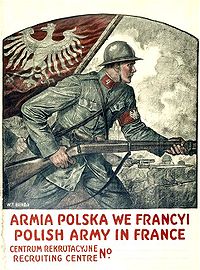Blue Army (Poland): Difference between revisions
Guy Peters (talk | contribs) m moved Blue Army to Blue Army (Poland): disambiguation |
|
(No difference)
| |
Revision as of 12:02, 5 July 2009

The Blue Army, or Haller's Army, are informal names given to the Polish Army units formed in France during the later stages of World War I. The army was created in June 1917 as part of the Polish units allied to the Entente. After the Great War ended, the units were transferred to Poland, where they took part in the Polish-Ukrainian War and the Polish-Bolshevik War. The nicknames come from the soldier's French blue uniforms and the name of the army's commander, General Józef Haller de Hallenburg.
History


The first units were formed after the signing of a 1917 alliance by French President Raymond Poincaré and the Polish statesman Ignacy Jan Paderewski. A majority of recruits were either Poles serving in the French army, or former prisoners of war from the German and Austro-Hungarian imperial armies (approximately 35,000 men). An additional 23,000 were Polish Americans. Other Poles flocked to the army from all over the world as well — these units included recruits from the former Russian Expeditionary Force in France and the Polish diaspora in Brazil (more than 300 men).
The army was initially under French political control and under the military command of General Louis Archinard. However, on February 23, 1918, political sovereignty was granted to the Polish National Committee and soon other Polish units were formed, most notably the 4th and 5th Rifle Divisions in Russia. On September 28 Russia formally signed an agreement with the Entente that accepted the Polish units in France as the only, independent, allied and co-belligerent Polish army. On October 4, 1918 the National Committee appointed General Józef Haller de Hallenburg as overall commander.
The first unit to enter combat on the Western Front was the 1st Rifle Regiment (1 pułk strzelców), fighting from July 1918 in Champagne and the Vosges mountains. By October the entire 1st Rifle Division joined the fight in the area of Rambervillers and Raon-l'Étape.
The army continued to gather new recruits after the end of The Great War on November 11, 1918, many of them ethnic Poles who had been conscripted into the Austrian army and later taken prisoners by the Allies. By early 1919 it numbered 68,500 men, fully equipped by the French government. After being denied permission by the German government to enter Poland via the Baltic port city of Danzig (Gdańsk), transport was arranged via train. Between April and June of that year the units were transported together intact to a reborn Poland across Germany in sealed train cars. Weapons were secured in separate cars and kept under guard to appease German concerns about a foreign army traversing its territory. Immediately after its arrival the divisions were integrated into the overall Polish Army and transported to the fronts of the Polish-Ukrainian War, then being fought over control of eastern Galicia. Haller's Army fought bravely in eastern Lesser Poland and in Volhynia, and its arrival allowed the Poles to repel the Ukrainians and establish a demarcation line at the river Zbruch.

In July 1919 the Army was transferred to the border with Germany, where it prepared defences against any possible German invasion.
Haller's well trained and highly motivated troops, as well as their airplanes and excellent FT-17 tanks, formed part of the core of the Polish forces during the ensuing Polish-Bolshevik War.
As with most of the history related to the Polish-Soviet War, information on the Blue Army was censored and repressed by the Soviet Union during its communist domination of the 1945-1989 People's Republic of Poland.
The 15th Infantry Rifle Regiment of the Blue Army was the basis for the 49th Hutsul Rifle Regiment of the 11th Infantry Division (Poland)
Order of battle
- I Polish Corps
- 1st Rifle Division
- 2nd Rifle Division
- 1st Heavy Artillery Regiment
- II Polish Corps - formed in Russia
- III Polish Corps
- 3rd Rifle Division
- 6th Rifle Division
- 3rd Heavy Artillery Regiment
- Independent Units
- 7th Rifle Division
- Training Division - cadre
- 1st Tank Regiment
See also
Bibliography
- Paul Valasek, Haller's Polish Army in France, Chicago, 2006
